It didn’t take long for Budapest to win us over. Within a day of exploring the Hungarian capital, we were smitten with its classical architecture and edgy vibe. The city is home to an exciting restaurant scene that offers a good mix of traditional Hungarian cuisine and modern takes on global comfort food.
Like any fast-food-starved consumer, Budapest’s myriad pizza and burger restaurants are what excited us the most but traditional Hungarian dishes like goulash, chicken paprikash, and stuffed cabbage are what truly warmed our hearts (and our bellies).
If you’re visiting Budapest or any other city in Hungary, then be sure to look for these 25 traditional Hungarian dishes. Like us, they made just warm your heart, and win you over.
HUNGARIAN FOOD QUICK LINKS
If you’re visiting Hungary and want to learn more about Hungarian cuisine, then you may be interested in joining a food tour.
TOURS & OTHER SERVICES
- Food Tours: Hungarian Food/Drinking Tours
- eSIM: Hungary eSIM
Save This on Pinterest!
No time to read this article on traditional Hungarian food? Click on the save button and pin it for later!
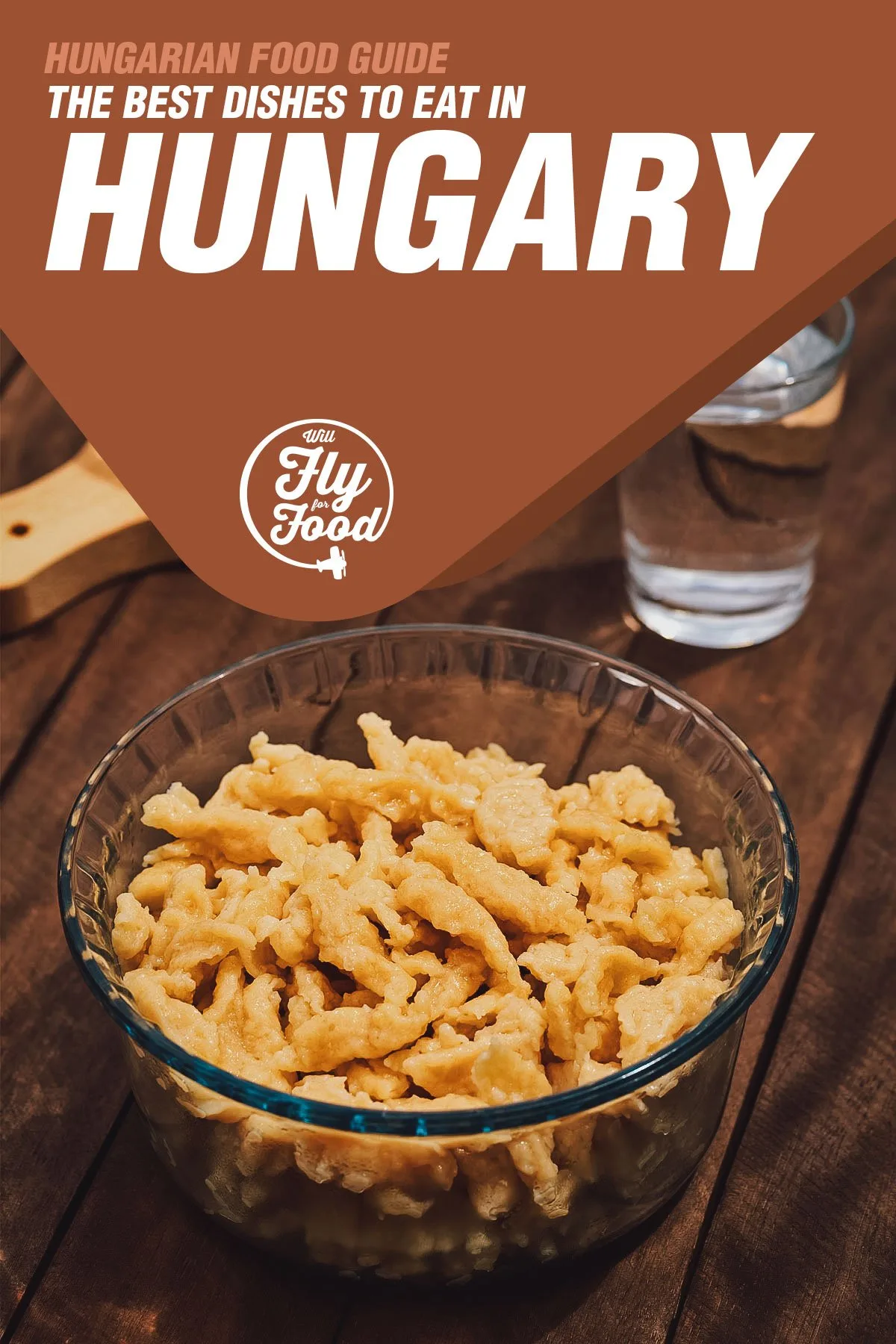
Photo by Ildi Papp
WHAT IS TRADITIONAL HUNGARIAN CUISINE?
Traditional Hungarian food has been described as a blend of Ottoman, Central Asian, and European (eastern, central, and southern) cuisines. It’s considered one of the spiciest cuisines in Europe, due largely to the heavy use of paprika in many Hungarian dishes.
Hungarian cuisine is traditionally a meat-heavy cuisine that incorporates a variety of seasonal vegetables, fruits, dairy products, and bread. Chicken, beef, and pork are the most commonly consumed proteins while lamb, turkey, duck, fish, and game meats are more often reserved for special occasions.
Aside from Hungarian paprika – which is known to be spicier than other types of paprika – other commonly used herbs and spices in Hungarian cuisine include garlic, caraway seeds, marjoram, dill seeds, and celery seeds.
Many Hungarian dishes are typically served with a side dish like dumplings, while bread is a vital staple food that’s eaten at all meals.
MUST-TRY HUNGARIAN DISHES
This article on traditional Hungarian food has been organized by category to make it easier to digest. Click on a link to jump to any section of the guide.
SOUP
1. Főzelék
Fozelek is a type of thick vegetable stew or soup. It’s a simple dish that can be made with a variety of different ingredients like peas, spinach, cabbage, potatoes, carrots, lentils, squash, or sorrel. The version of fozelek pictured below is called zordborsofozelek, or green pea stew.
Fozelek is commonly eaten as a main course for lunch, either on its own or topped with additional ingredients like fried eggs, sausage, or meatballs.
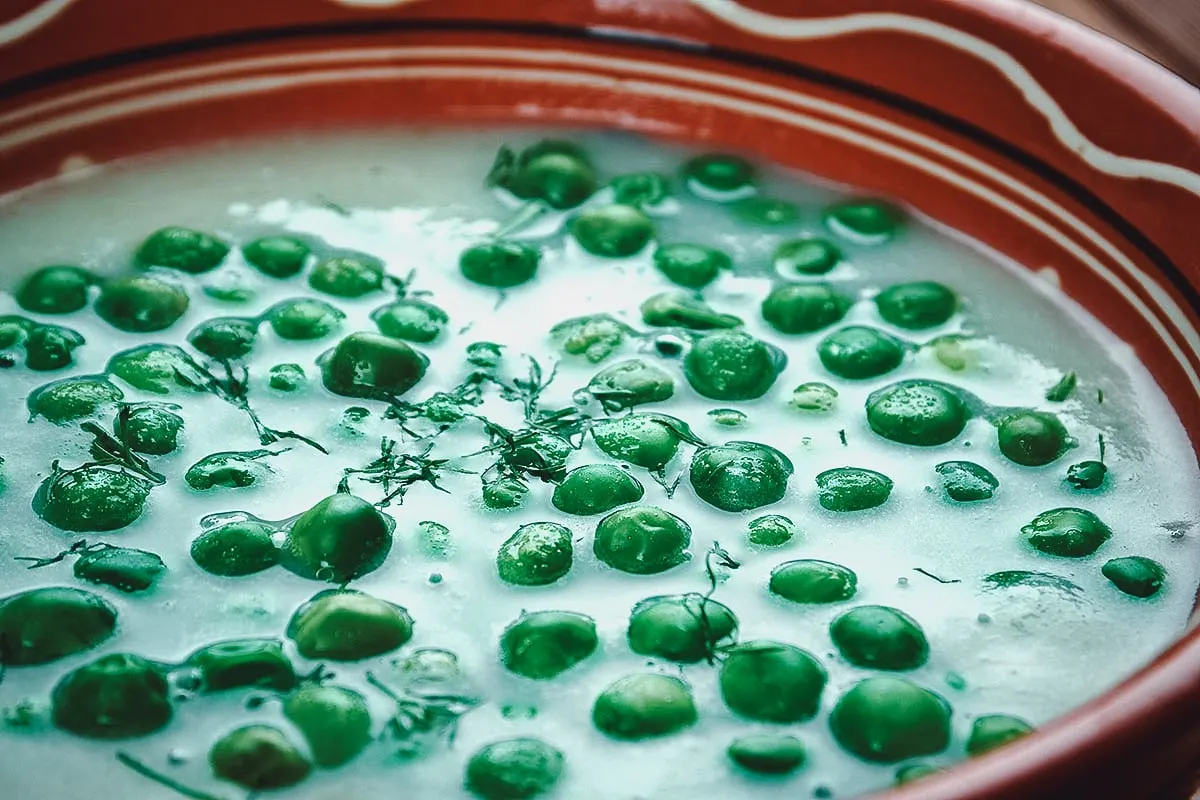
Photo by Fanfo
Here’s a version called spenotfozelek, or spinach stew.
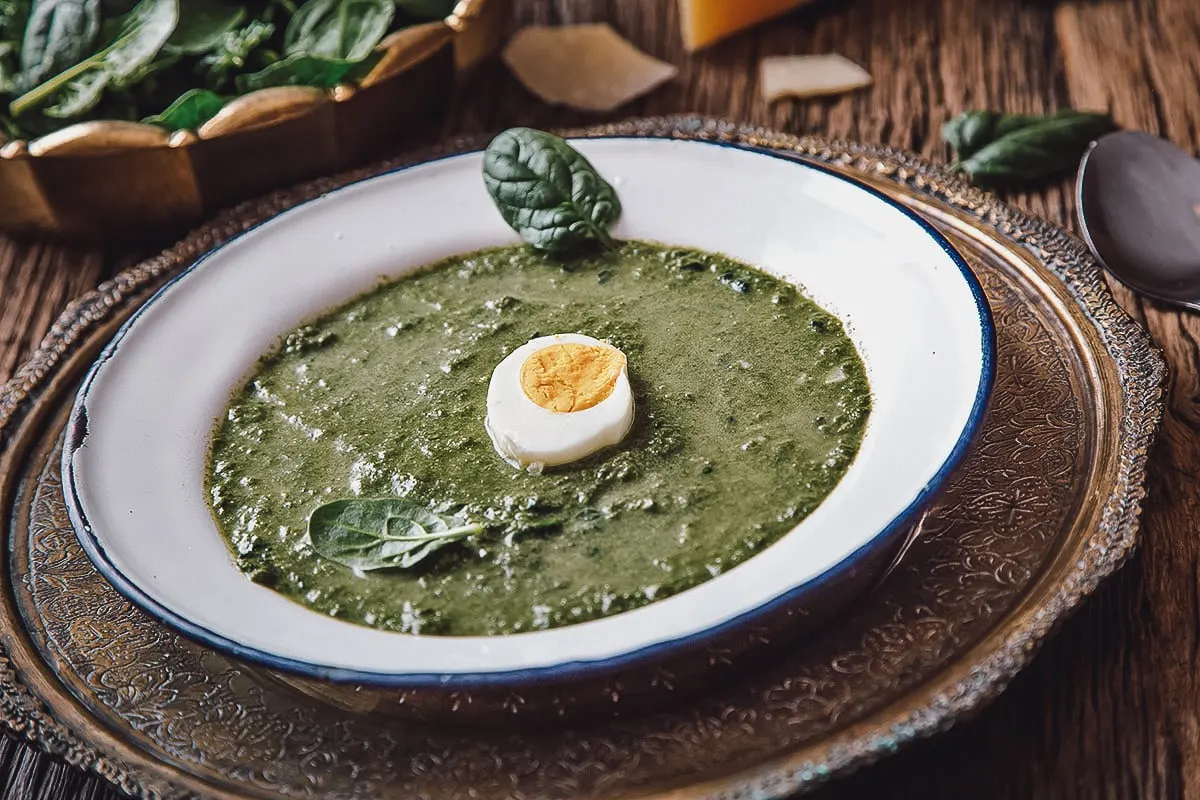
Photo by Marian Weyo
2. Halászlé
Halaszle refers to a traditional Hungarian fisherman’s soup. It’s typically made from freshwater fish like carp, pike, or bass cooked in a rich and spicy broth flavored with onions, tomatoes, paprika, sweet paprika, and other ingredients. Hungarian paprika, an often-used ingredient in Hungarian food, is what gives the soup its distinctive red color.
Originally from the Szeged region of Hungary, halaszle was traditionally prepared over open fires along the riverbanks. It’s a hearty and warming soup that becomes even more popular in winter, especially at festivals and family gatherings.
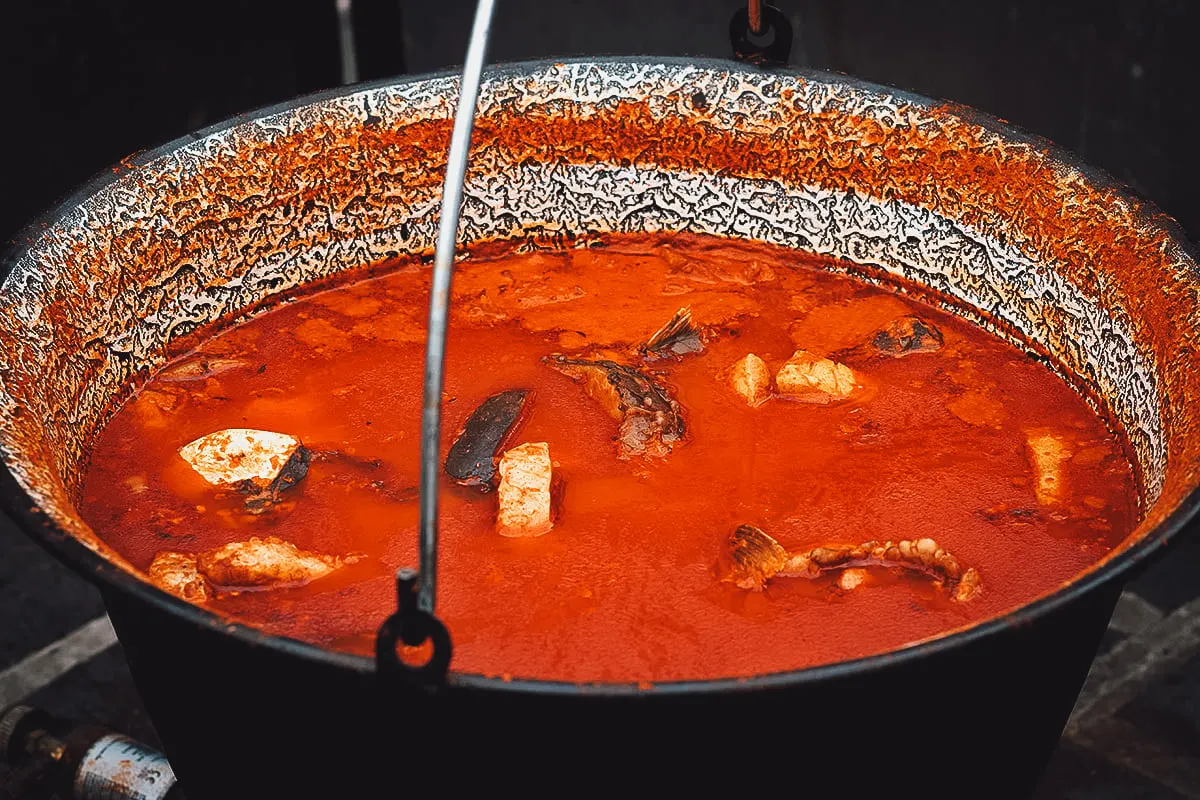
Photo by Morana Photo
3. Orjaleves
If you like rich meaty soups, then you may want to try orjaleves. It refers to a slow-cooked Hungarian pork soup made with baby back ribs. Cooked with vegetables and pasta, the ribs are cooked for about two hours until they become fall-off-the-bone tender.
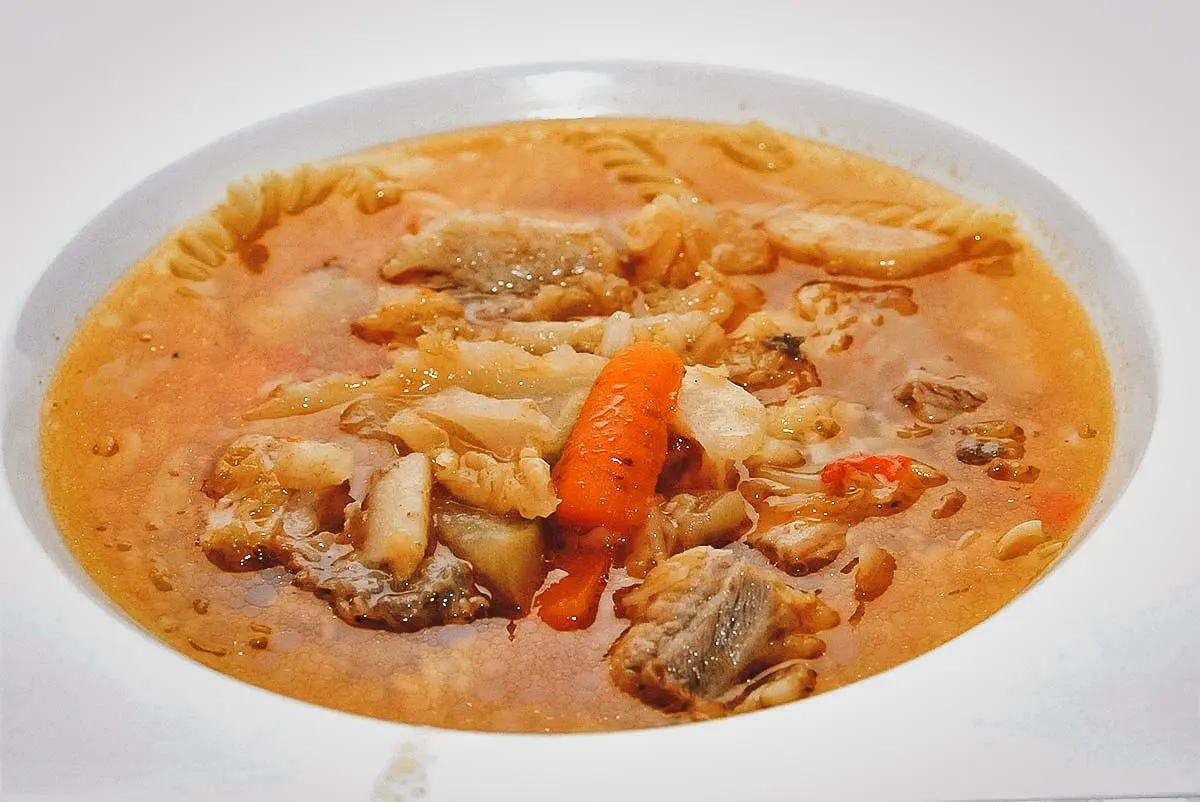
Claus, CC BY-SA 3.0 DE, via Wikimedia Commons / Processed in Photoshop and Lightroom
4. Jókai Bableves
Jokai bableves is a hearty Hungarian soup made with dried beans – like kidney, pinto, or navy beans – cooked with smoked pork, vegetables, egg noodles, Hungarian paprika, and other spices. It’s often topped with sour cream and commonly eaten during the winter months because of its warming properties.
Interestingly, jókai bean soup gets its name from a famous Hungarian writer named Mór Jókai. He was said to be a regular at a Balatonfüred restaurant where he almost always ordered this soup.
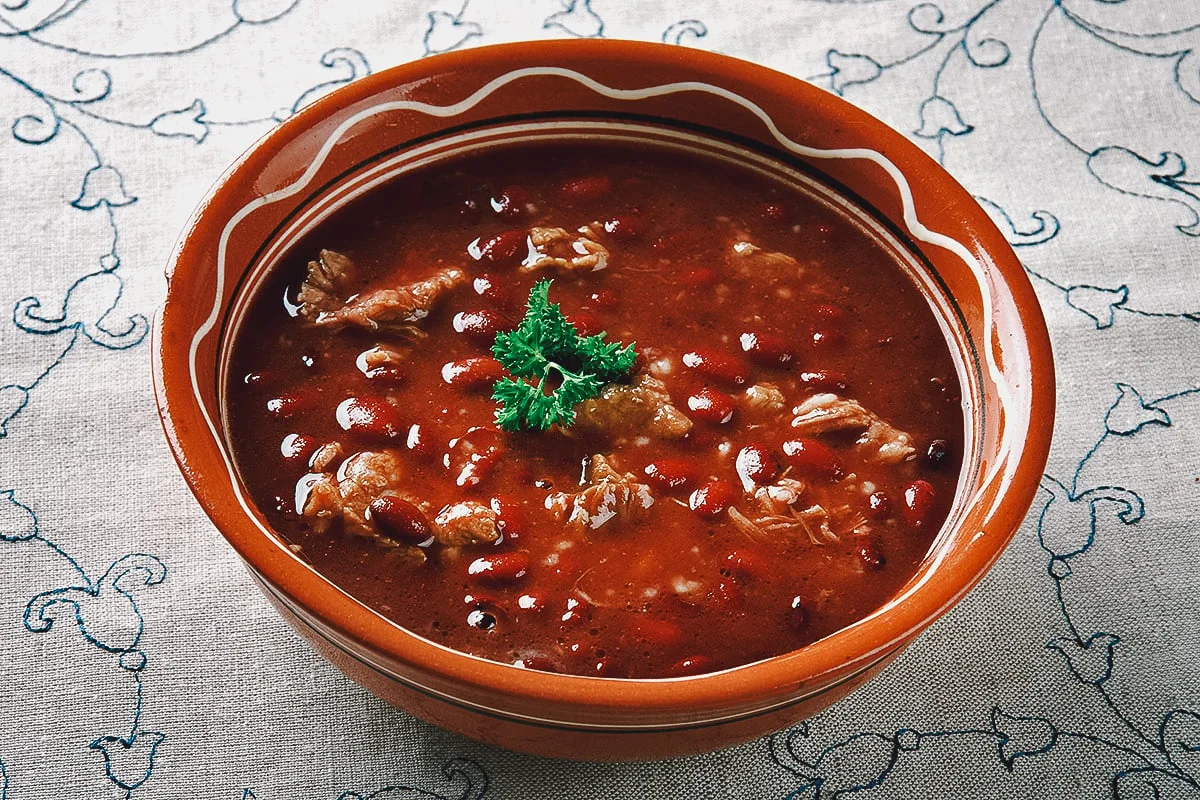
Photo by Fanfo
5. Meggyleves
If you’re accustomed to eating hot savory soups, then your first spoonful of meggyleves may come as a surprise to you. It refers to a Hungarian sour cherry soup made with whole fresh sour cherries, sour cream, sugar, and other ingredients like cloves and cinnamon.
A popular summer delicacy, Hungarian sour cherry soup is traditionally served over dinner, either as an appetizer or for dessert.
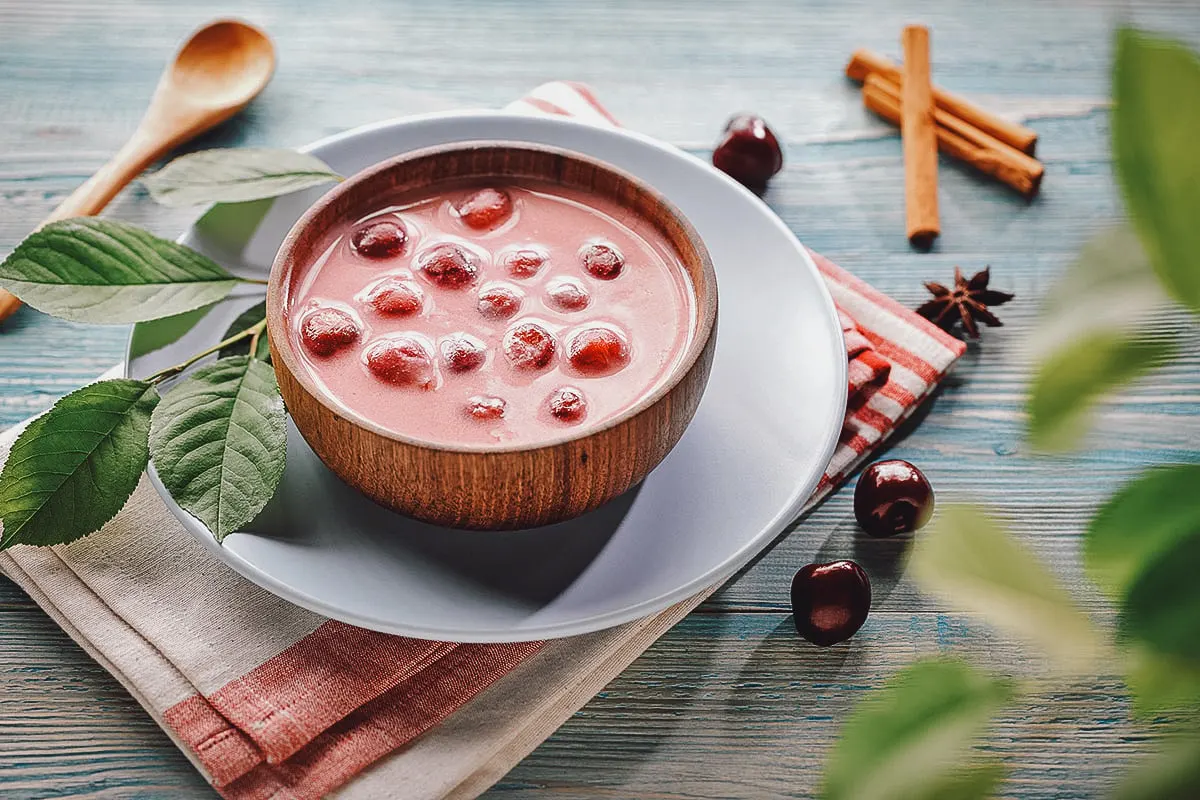
Photo by Mike Laptev
STARTERS / SIDES / SNACKS
6. Körözött
Some people like sampling local beers when they travel. Others go for sausages. If you like trying different types of unfamiliar cheese, then you may want to try korozott. It refers to a spicy cheese spread popular in Hungary and in other countries where it goes by different names like smirkas (Slovakia), liptauer (Austria), liptaver (Slovenia), and liptao (Albania).
Korozott is made with a spreadable white cheese like cottage cheese or quark, along with paprika, onions, butter, caraway seeds, and other spices. It’s typically chilled and served as a spreadable appetizer with bread, crackers, or fresh vegetables.
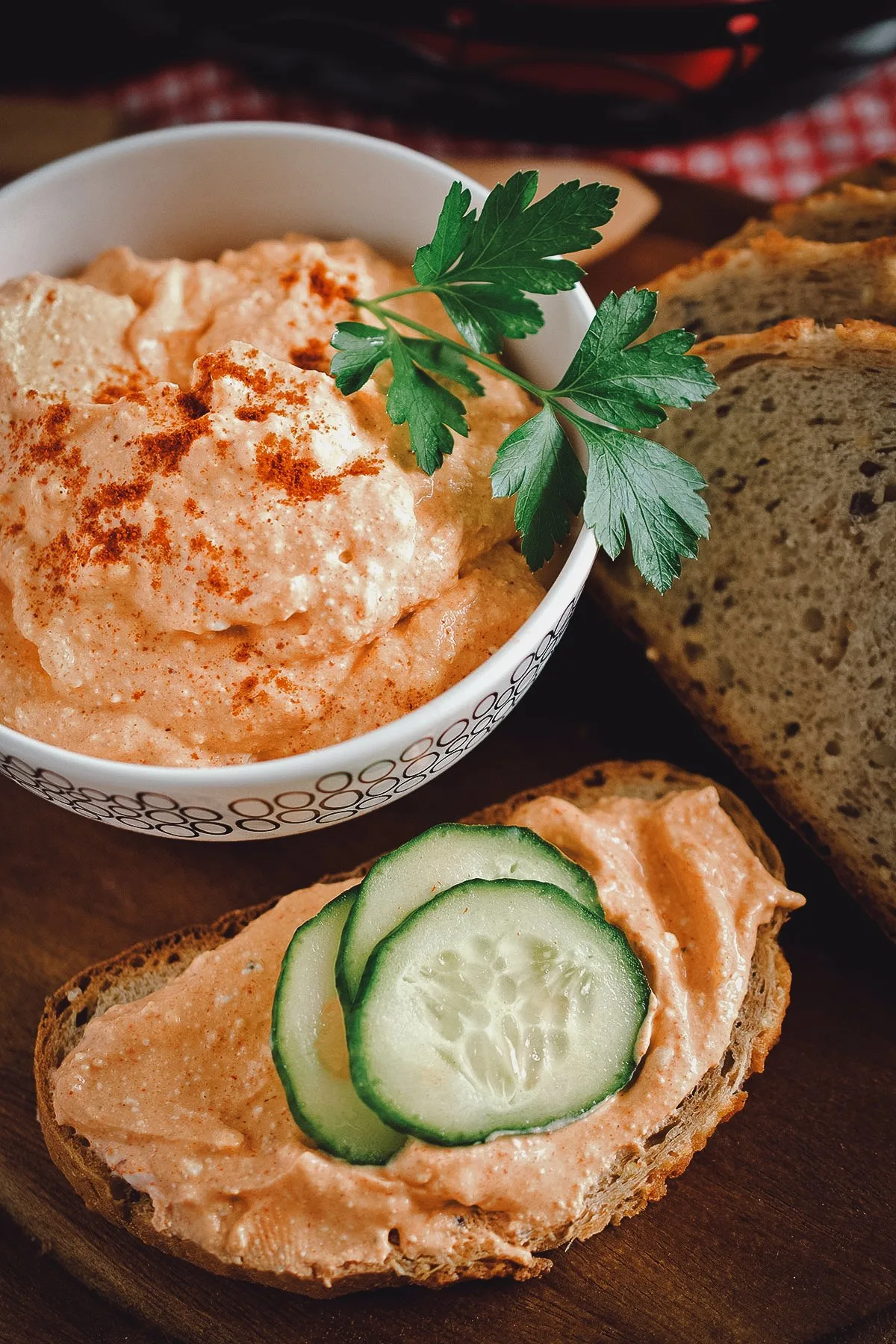
Photo by pingpongcat
7. Lecsó
Lecso is basically a type of Hungarian vegetable stew or ratatouille. It’s made from Hungarian wax peppers (or bell peppers, banana peppers) and tomatoes sauteed in lard or bacon fat with onions, paprika, and other seasonings.
Lecso is especially popular in the summertime or in early autumn, when the best peppers and tomatoes are in season. It can be enjoyed on its own or served as a side dish, usually with bread.
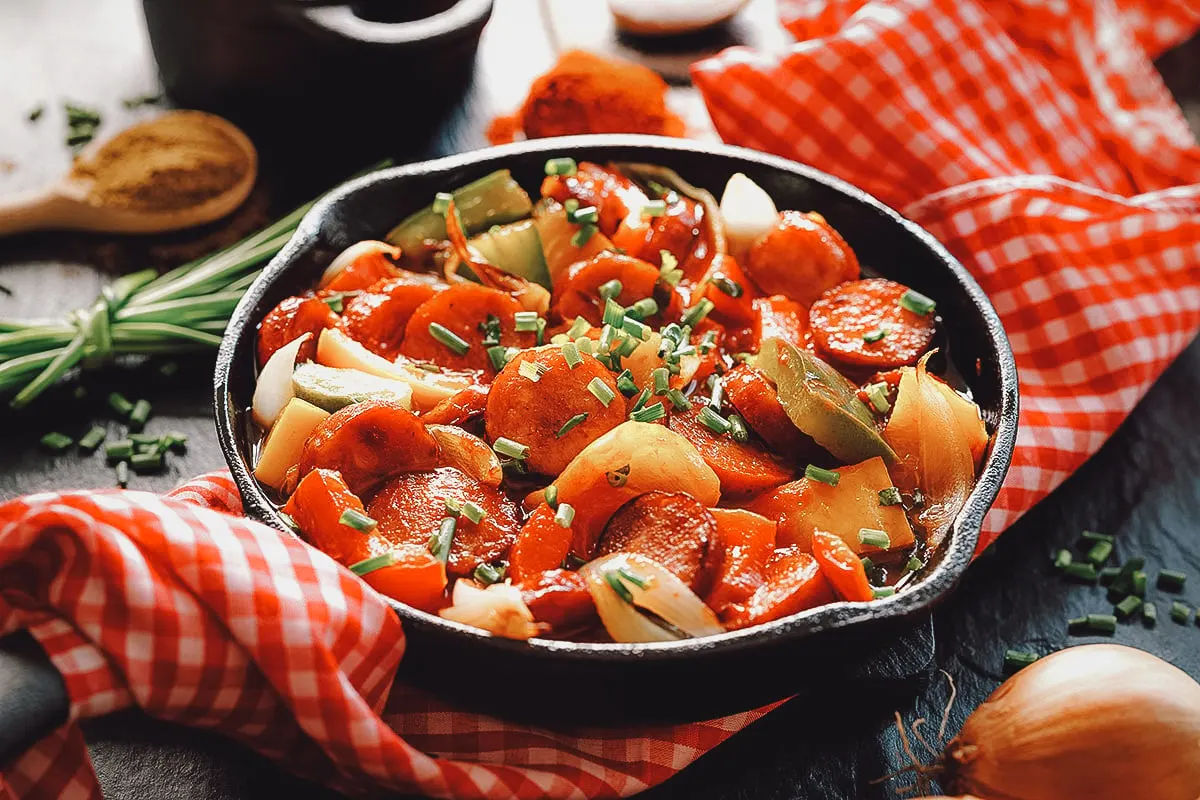
Photo by zi3000
8. Rántott Sajt
Cheese is irresistible on its own, but even more so when it’s breaded and fried. You’ll find some form of fried cheese dish in many countries but in Hungary, the dish to look for is rantott sajt.
Meaning “fried cheese” in Hungarian, rantott sajt is made with a semi-hard or hard cheese – most commonly Trappista cheese – that’s coated in a breading mixture before being deep-fried to a golden brown. It usually comes in rectangular or triangular shapes and served with tartare sauce and a side of french fries or rice.
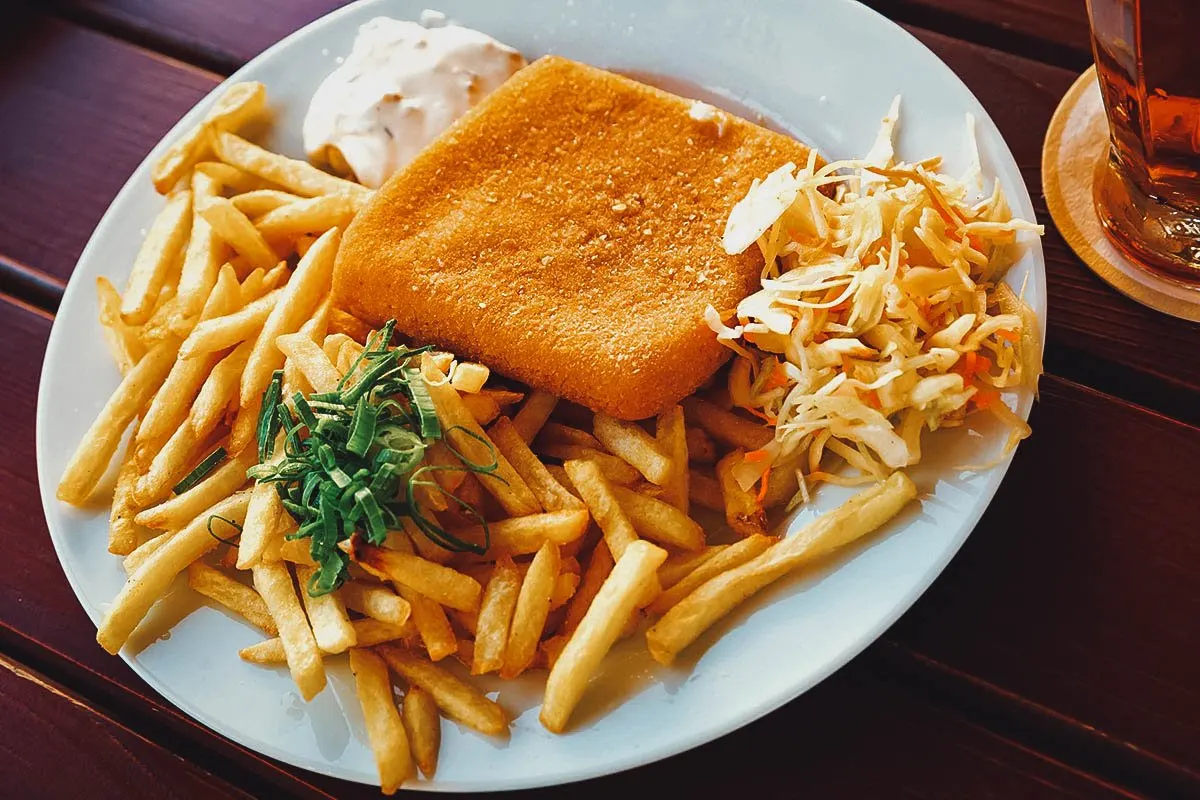
Photo by Jim_Filim
9. Libamaj
When thinking of the world’s most decadent food products, many people will probably say the same things – caviar, lobster, Kobe beef, foie gras, etc.
A popular but controversial ingredient, foie gras in Hungary is known as libamaj. I didn’t realize this until our visit but Hungary is known to be the third-largest producer of foie gras in the world, behind France and Bulgaria.
In Hungary, libamaj is traditionally fried in goose fat. It can also be roasted or smoked or made into a paté or mousse. Pictured below are some less expensive tins of libamaj commonly sold at Budapest’s markets.
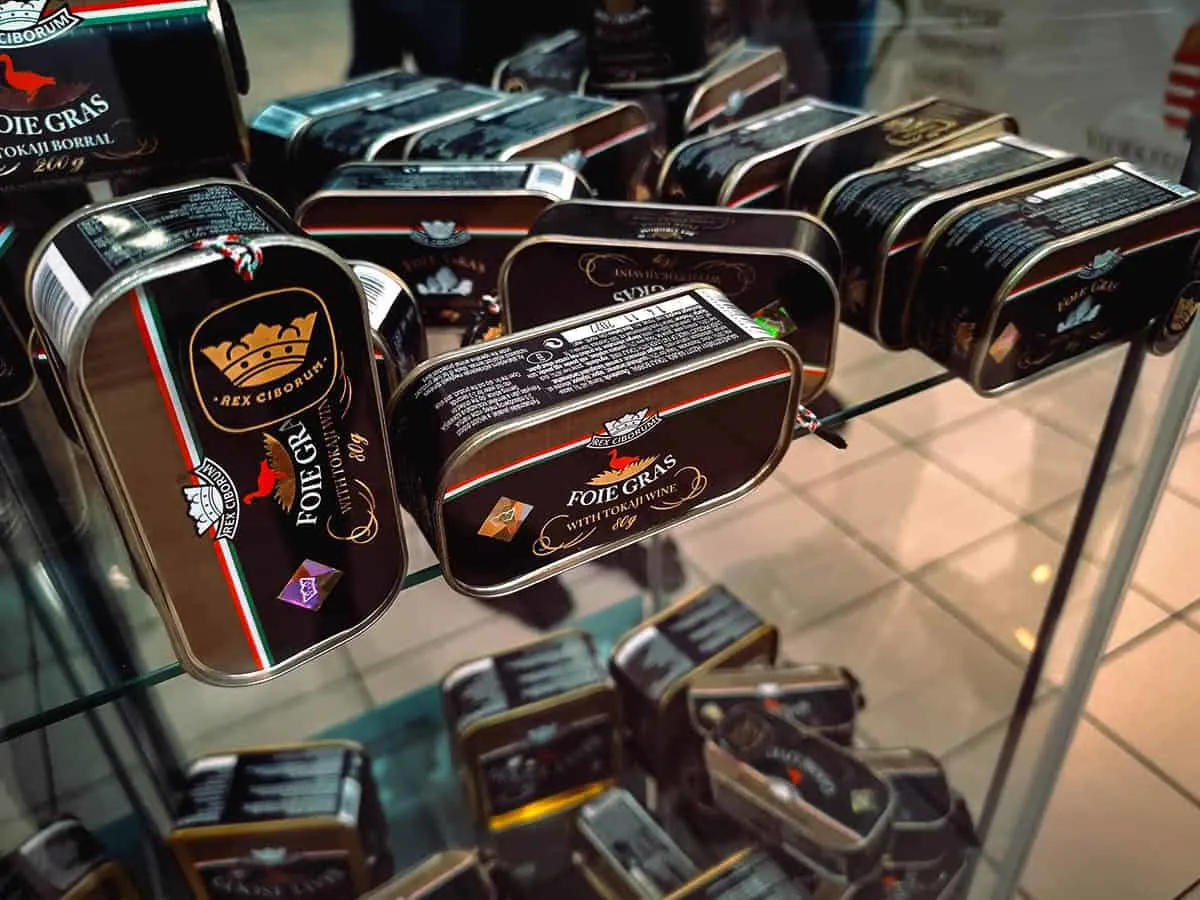
10. Lángos
If you were to have just one street food dish in Budapest, then it should probably be langos (or maybe chimney cake). It refers to a type of Hungarian deep-fried flat bread that’s commonly sold at markets, street food stalls, and festivals.
Langos can be eaten on its own, brushed simply with garlic, or it can be topped with a variety of ingredients like grated cheese, korozott, sour cream, sausage, ham, or mushroom. It can even be topped with sweet ingredients like Nutella, jam, or powdered sugar.
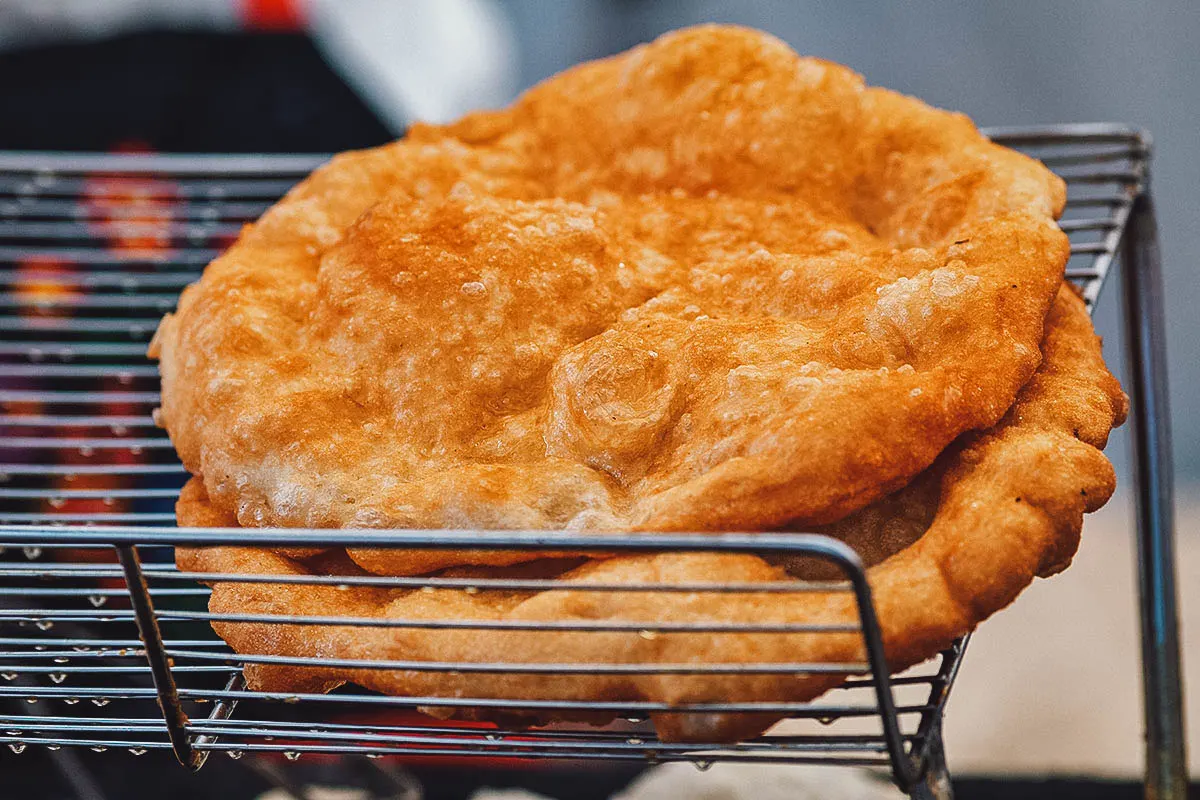
Photo by [email protected]
Here’s a pair of less conventional langos dishes we tried at restaurants in Budapest. The one in the foreground was topped with arugula and sheep cheese while the one behind it is a langos burger.
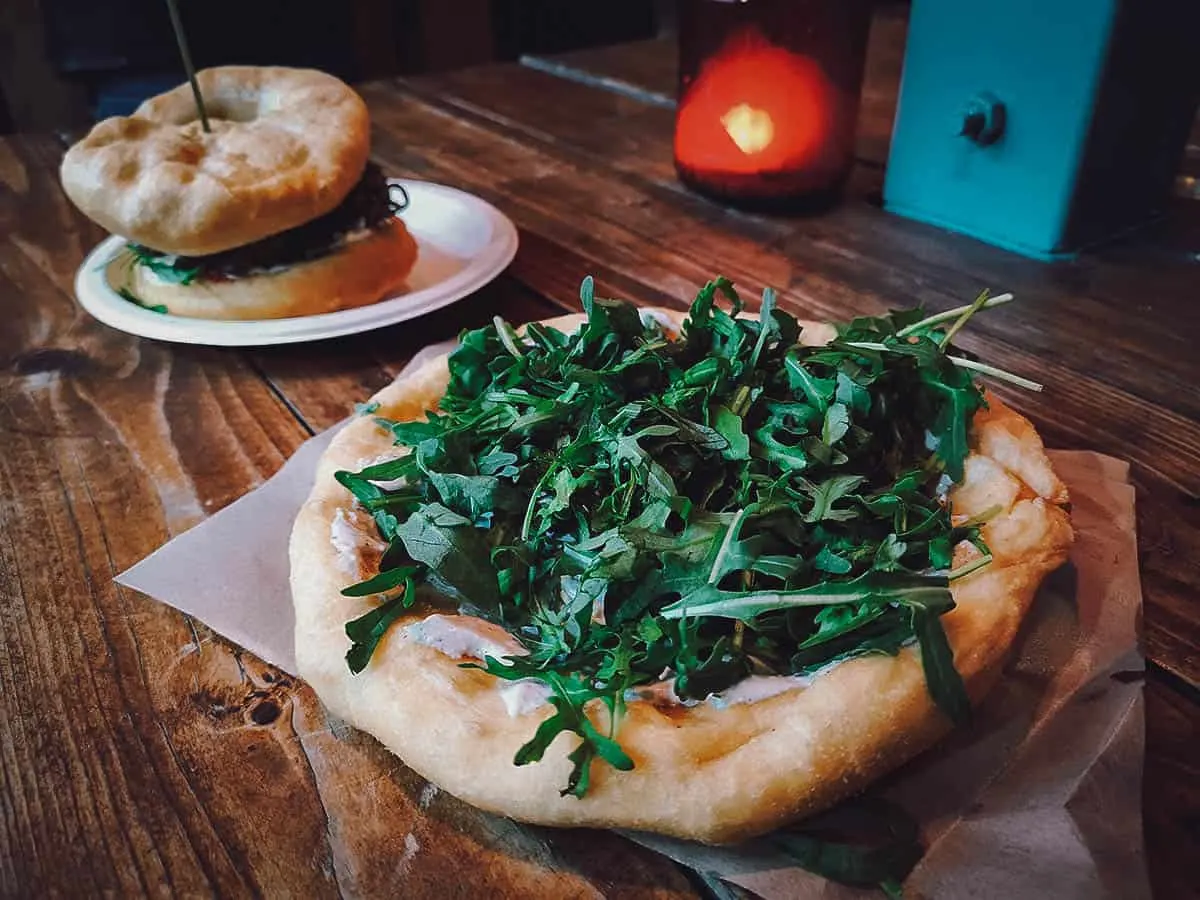
11. Nokedli
You probably won’t order this next dish directly but you’ll have it often anyway in Hungary. A staple in Hungarian cuisine, nokedli refers to a type of soft dumpling or egg noodle dish similar to German spaetzle.
To prepare, a sticky batter made with flour, eggs, and water is spooned or pressed through a noodle grater into boiling water. The dumplings are boiled briefly before floating to the surface when cooked.
Nokedli can be enjoyed on their own with butter or served as a side dish, similar to rice or pasta. They’re commonly served with chicken paprikash or added to soups and stews like Hungarian goulash.
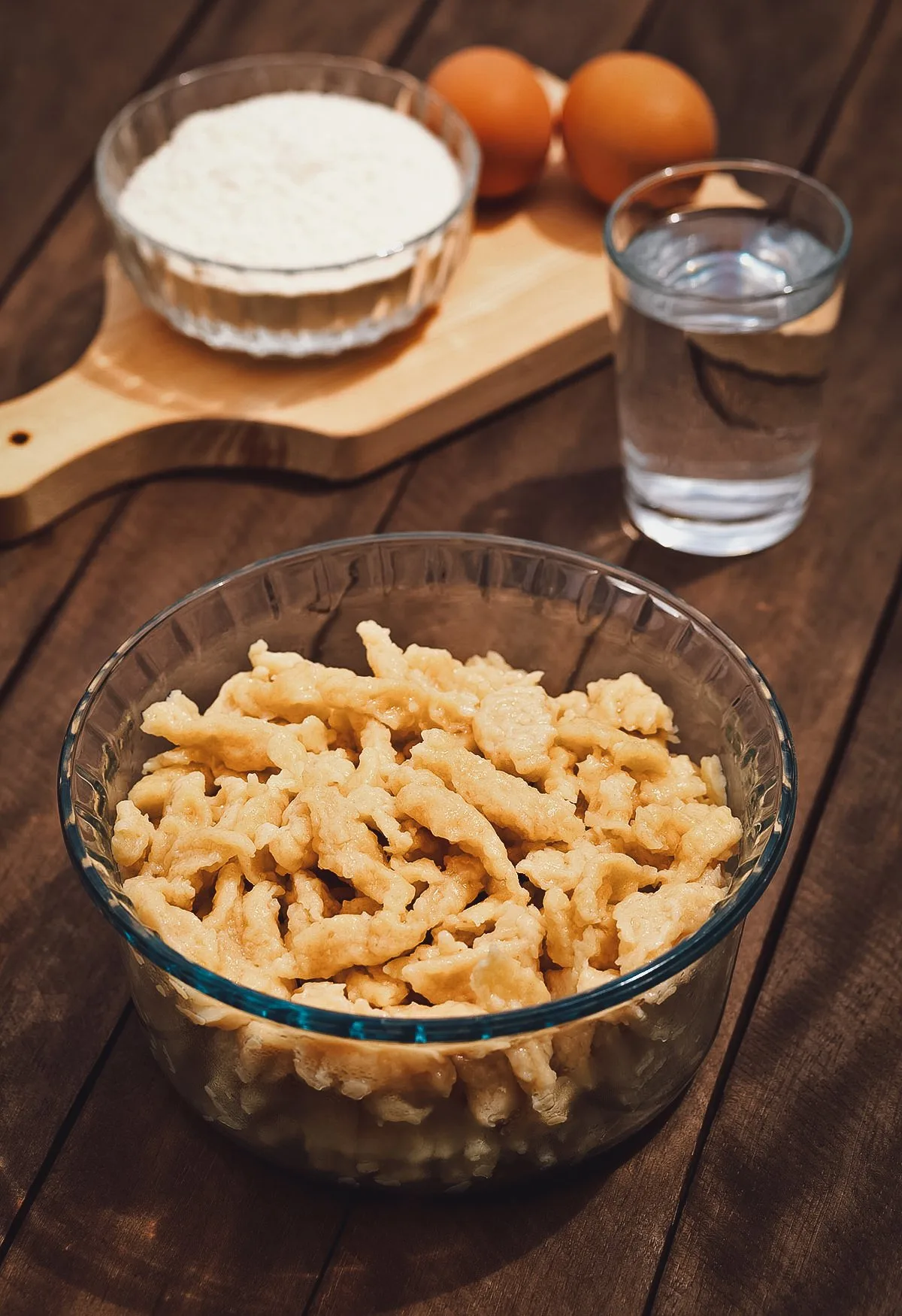
Photo by Ildi Papp
MAINS
12. Túrós Csusza
Turos csusza refers to a rustic cottage cheese pasta dish made with fried szalonna as its key ingredient. Similar to Italian lardo or Slavic salo, szalonna is a type of Hungarian smoked bacon or pork fatback commonly used in Hungarian cuisine.
Turos csusza is made with flat and wide egg noodles (csusza) mixed with cottage cheese (turo), szalonna, and sour cream. It’s a beloved comfort food in Hungary that’s often enjoyed as a main course at family gatherings.
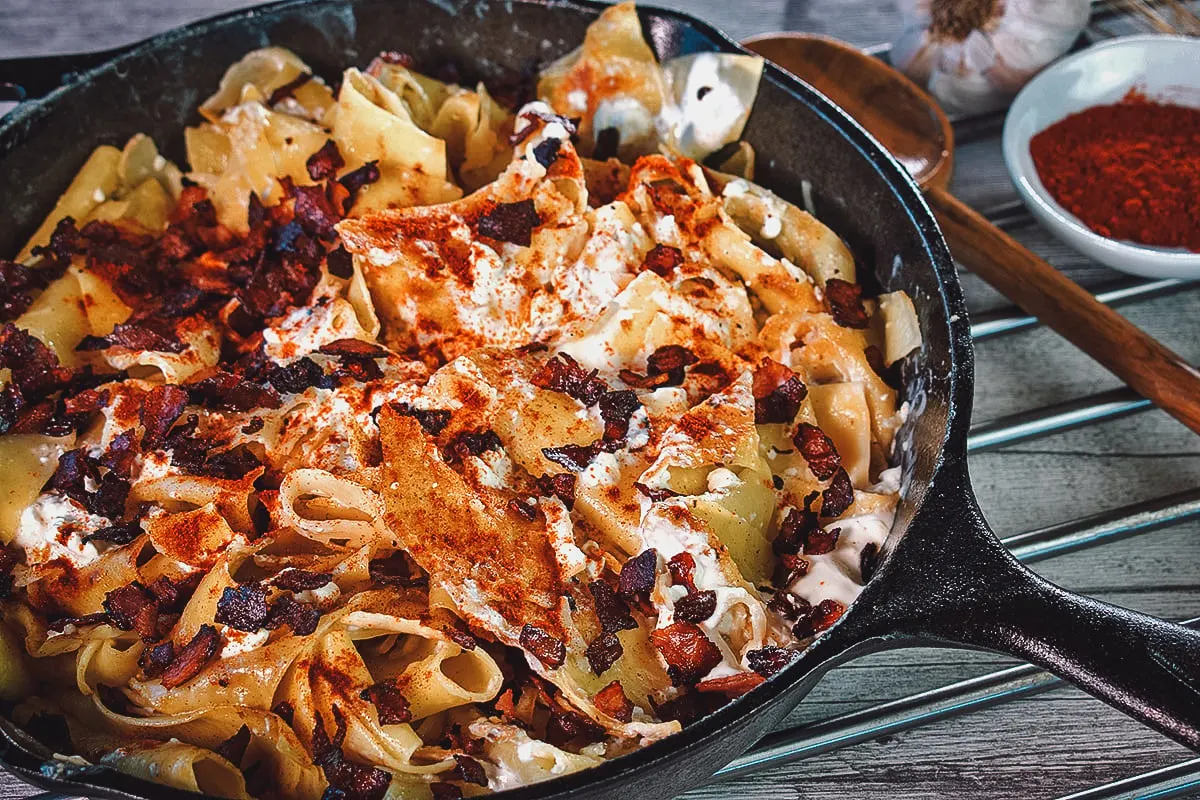
Photo by Angelika Heine
13. Töltött Kaposzta (Hungarian Stuffed Cabbage Rolls)
Stuffed cabbage rolls are a common dish in many European countries like Croatia, Poland, Romania, Armenia, and Bosnia and Herzegovina.
In Hungary, it’s called toltott kaposzta. A variety of ingredients like ground beef, smoked pork, rice, onions, and spices are rolled in fresh cabbage leaves before being cooked in a tomato-based sauce.
If you like stuffed peppers (dolma), then you’re probably going to enjoy toltott kaposzta. It’s a comforting dish that’s commonly served on a bed of sauerkraut with a generous dollop of sour cream.
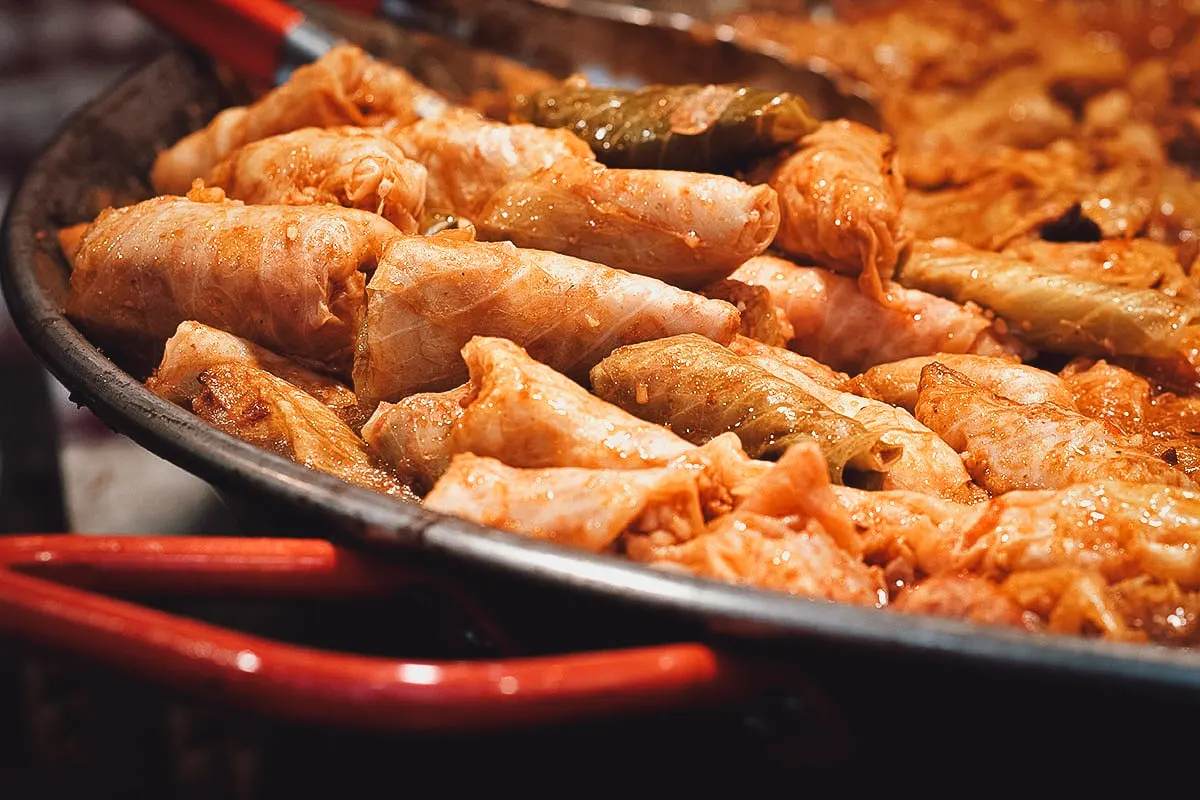
Photo by Morana Photo
14. Paprikás Csirke (Chicken Paprikash)
Like gulyas, paprikas csirke or chicken paprikash is one of the most well-known dishes in Hungary. It refers to a rustic chicken stew made with pieces of bone-in chicken – like thigh or drumsticks – cooked in a rich paprika-flavored sauce.
Chicken paprikas was one of the dishes I was most excited to try in Hungary. It’s a soulful comforting dish that’s commonly served with nokedli (or rice) and dollop of sour cream.
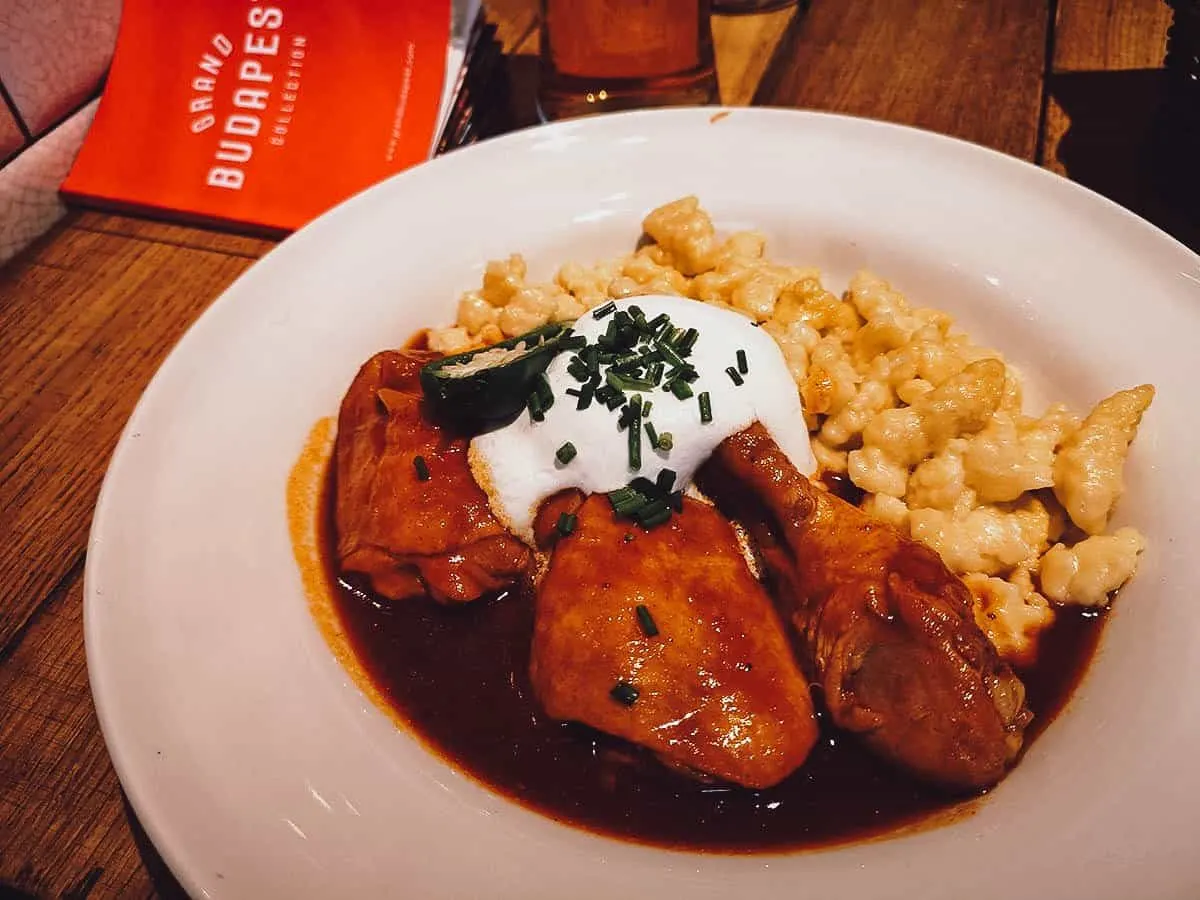
15. Pacal Pörkölt
If you’re a fan of tripe like I am, then you’ll definitely want to try this Hungarian tripe stew called pacal porkolt. It’s a traditional Hungarian dish made with strips of tripe stewed in a rich sauce flavored with onions, garlic, paprika, and other spices.
Be sure to eat this hearty dish with some freshly baked crusty bread for the most satisfying experience. Just looking at this picture is making me hungary! (sorry)
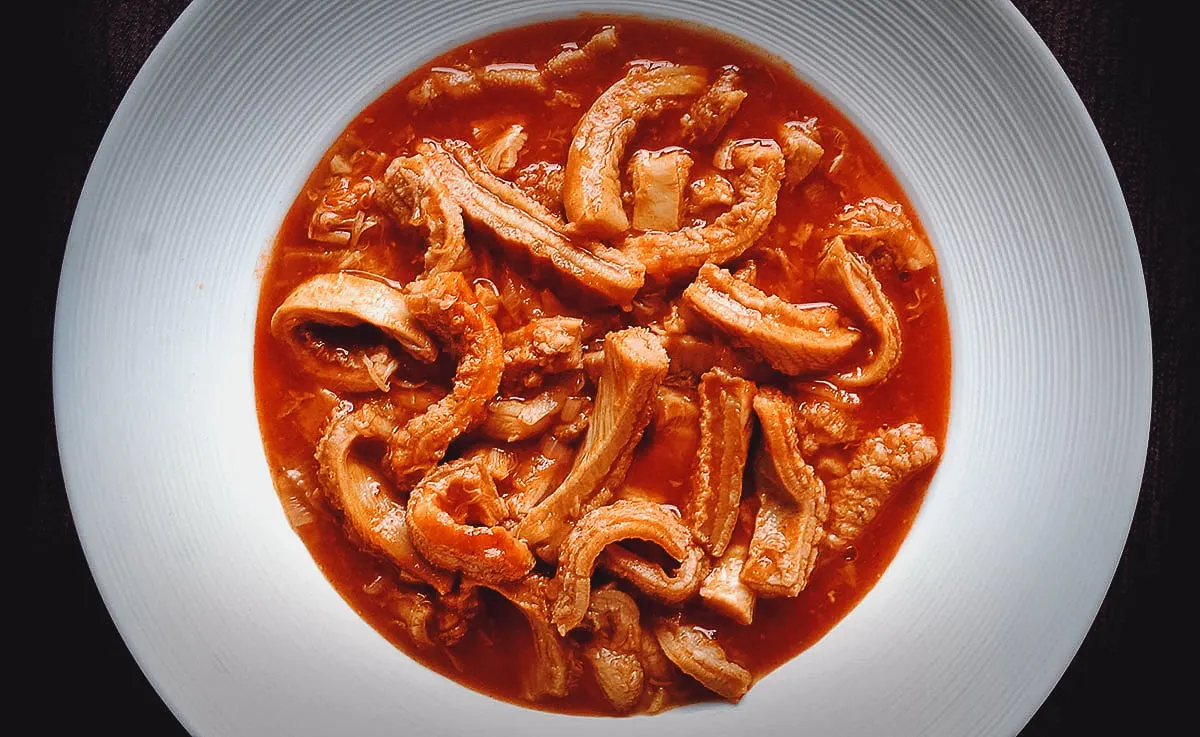
Photo by Pozhar_S
16. Hortobagyi Palacsinta
Hortobagyi palascinta refers to savory Hungarian crepes filled with a stew-like preparation of ground meat, usually veal or beef.
To prepare, the meat is stewed with onions, tomatoes, peppers, paprika, and garlic before being drained of sauce and stuffed into thin crepes (palascinta). The sauce is then generously poured over the filled crepes and finished off with a dollop of sour cream.
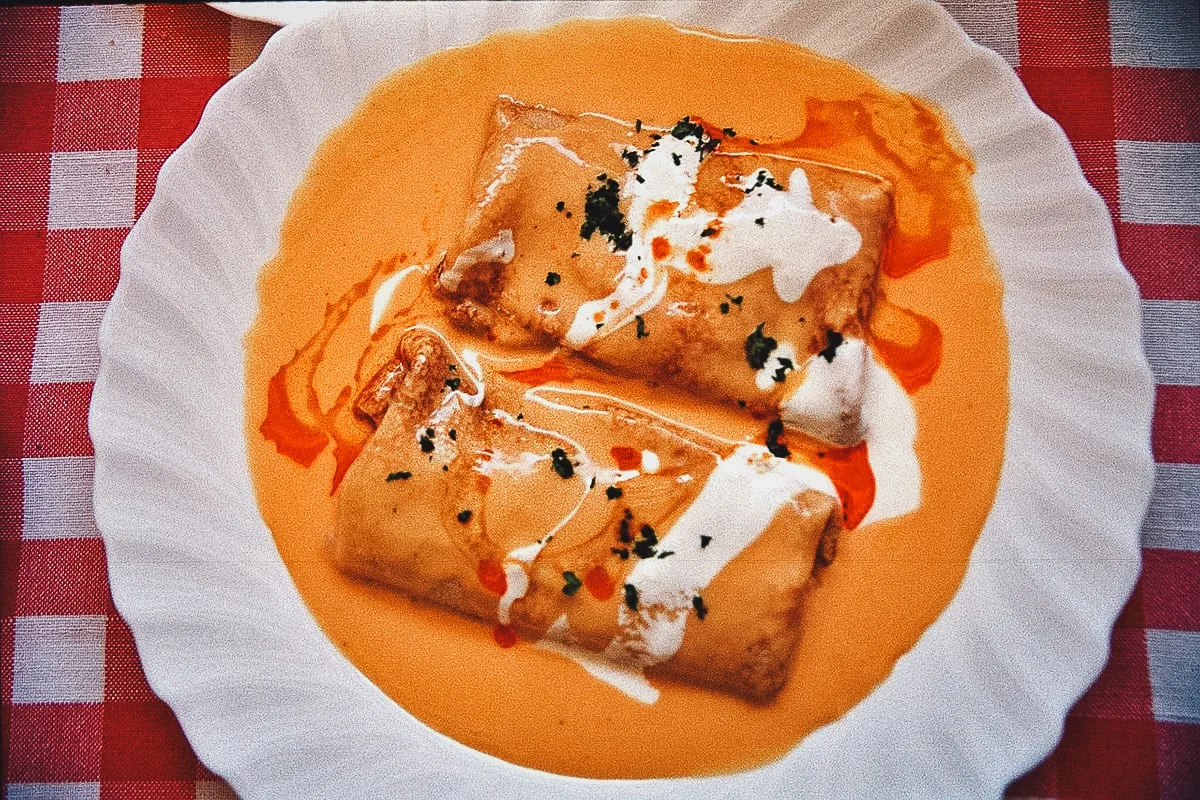
I, Themightyquill, CC BY-SA 3.0, via Wikimedia Commons / Processed in Photoshop and Lightroom
17. Gulyás (Goulash)
There are many tasty meat dishes in Hungary but none are more well-known than gulyas or goulash, a hearty meat stew cooked with vegetables and seasoned with paprika. It’s widely considered to be a Hungarian national dish, something many people think of when they think of Hungary.
The origins of this emblematic Hungarian dish can be traced all the way back to the 10th century. It was consumed by shepherds who’d dry the cooked meat under the sun and store it in bags made from sheep’s stomachs. Interestingly, these early versions of gulyas weren’t made with paprika since the spice wasn’t introduced to Europe until the 16th century.
Gulyas stems from the Hungarian word gulya, meaning “herd of cattle”. Gulyas literally means “herdsman” or “cowboy” in Hungarian, but it’s also used to refer to this hearty meat stew.
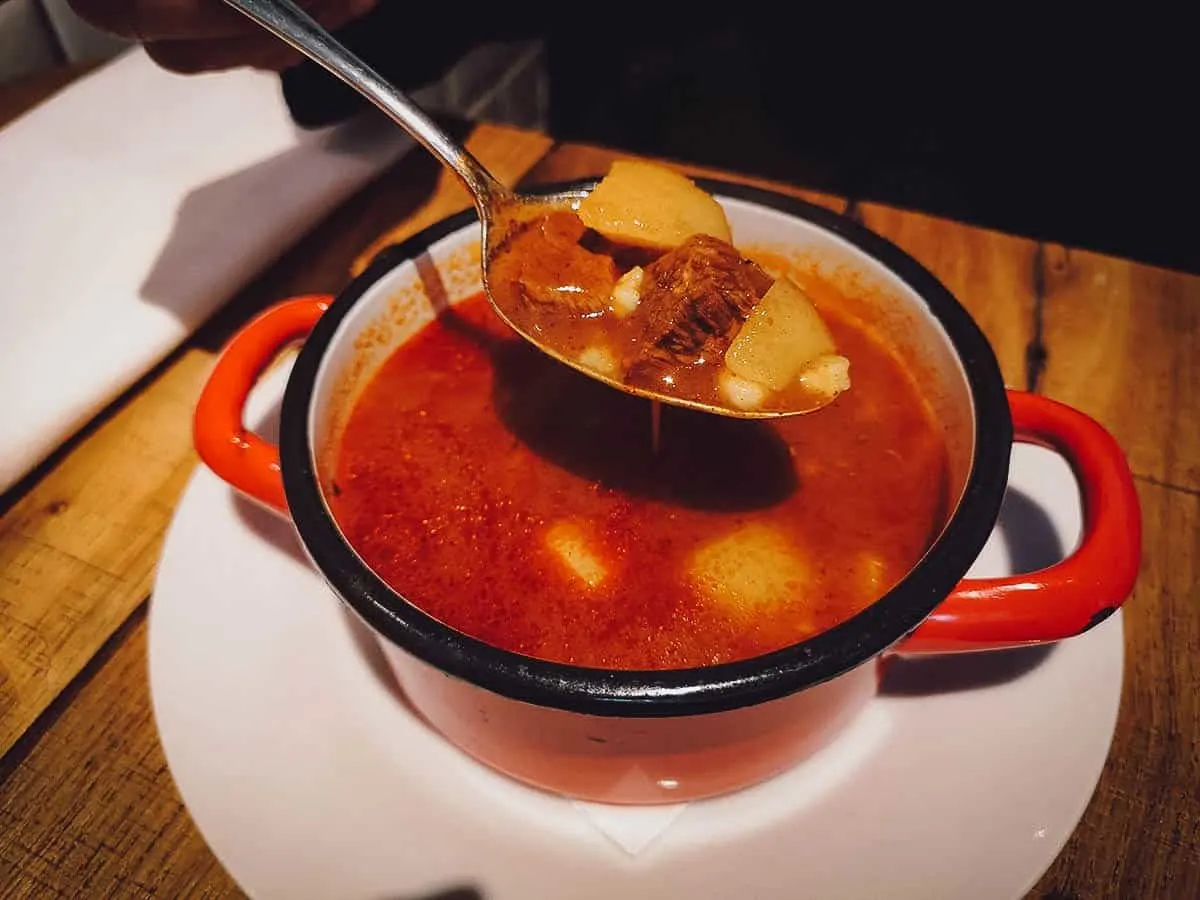
DESSERTS
18. Somlói Galuska
Somloi galuska is a type of Hungarian trifle made with layers of sponge cake interspersed with pastry cream, ground walnuts, and raisins. It’s traditionally served by “scooping” three balls of the trifle cake onto a plate or bowl, and then topping it with a generous amount of whipped cream and dark chocolate sauce.
Curiously, the word galuska literally means “dumpling”, perhaps in reference to the way this popular Hungarian cake is traditionally served.
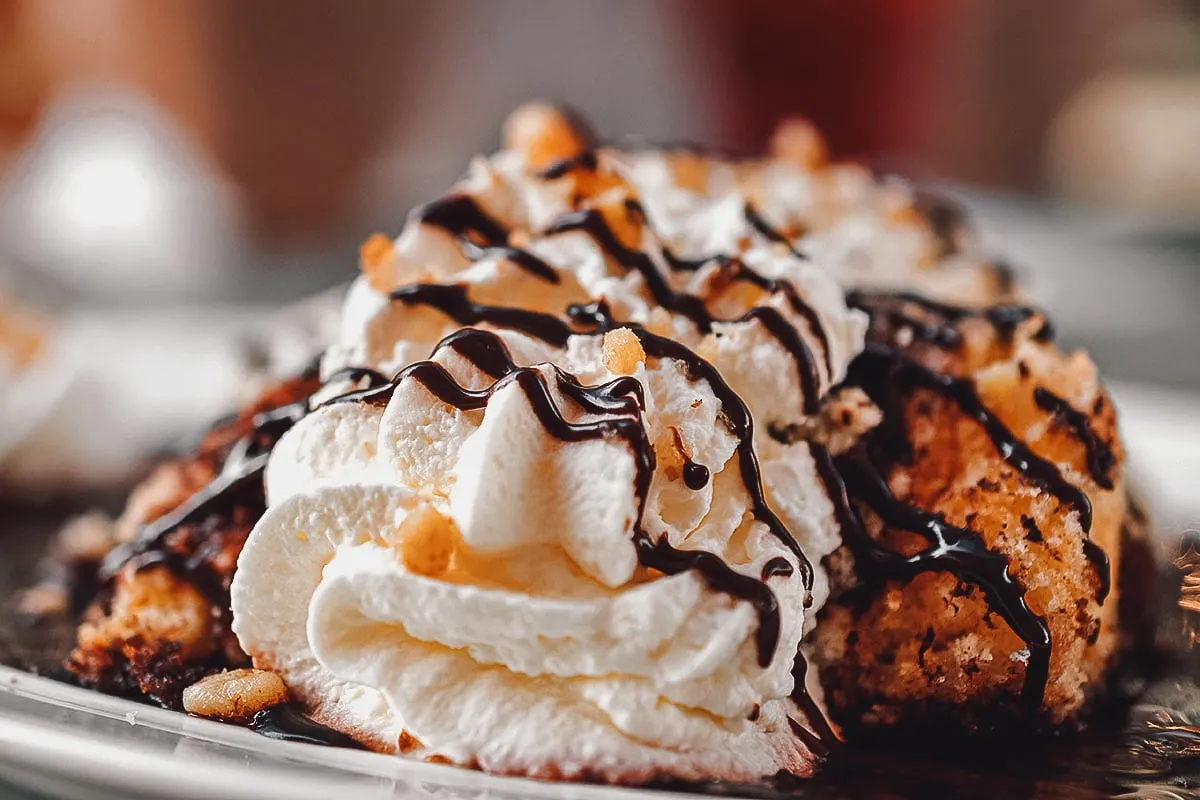
Photo by Krisztian Tefner
19. Kürtöskalács
I usually prefer savory dishes over sweets but Hungarian food may be an exception, and it’s all because of this incredibly delicious spit cake known as kurtoskalacs.
Kurtoskalacs literally means “chimney cake” and refers to these chimney-shaped cakes made with yeasted dough. The dough is coated in sugar before being roasted over charcoal around a cylindrical rod and basted with melted butter.
Thanks to its sugary coating, Hungarian chimney cake is known for having a crisp, caramelized exterior and a soft, buttery interior. When it’s done baking, it can be topped with additional ingredients like ground walnuts or cinnamon powder.
Kurtoskalacs is delicious on its own but it’s even better when stuffed with a serving of vanilla ice cream. My god was this good!
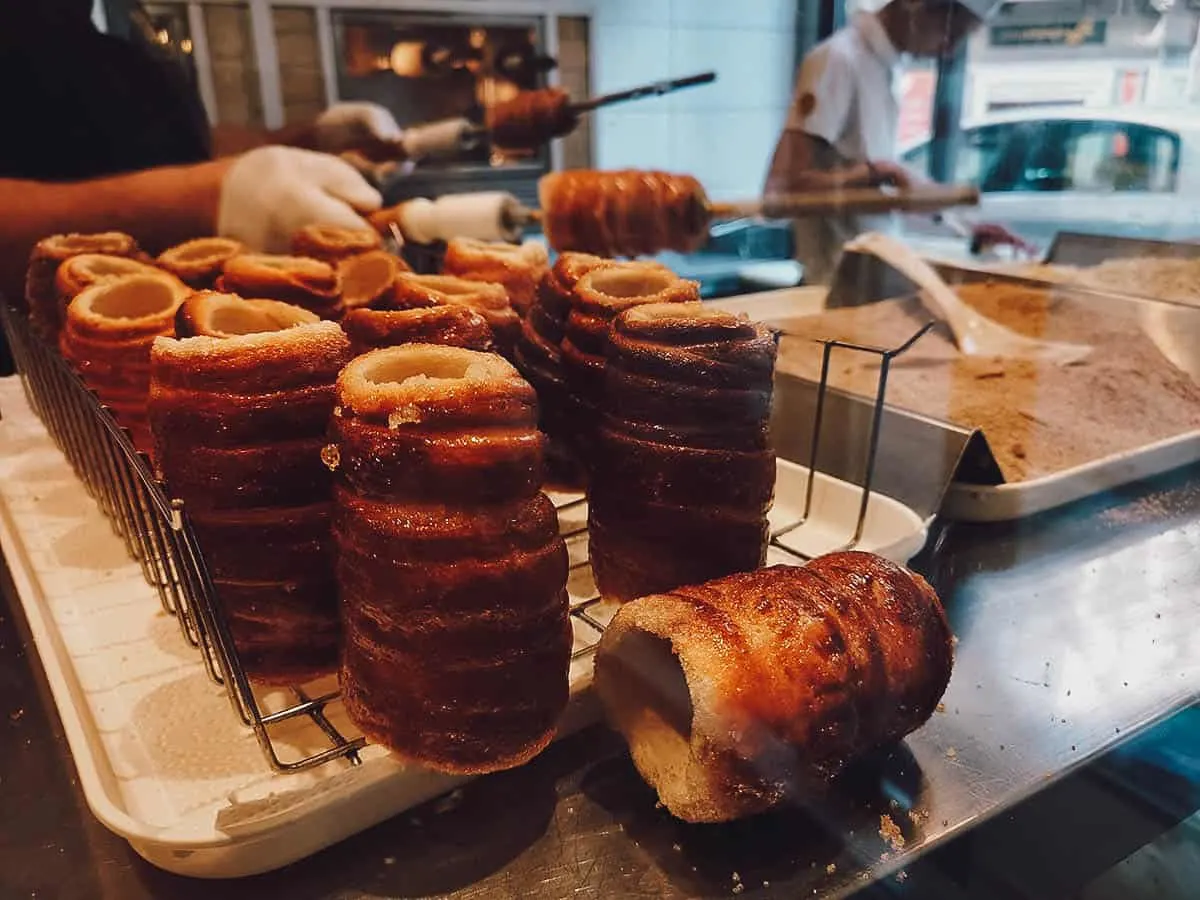
20. Dobos Torte
Dobos torte is another Hungarian dessert that you need to try in Budapest. It refers to a sponge cake layered with chocolate buttercream and topped with a crackingly crisp layer of caramel glaze.
Dobos torte is named after its inventor – Hungarian confectioner Jozesf Dobos. He devised the recipe sometime in the late 1800s (in an era before refrigeration) when he wanted to create a cake that would keep longer than other pastries.
Dobos coated the sides of his cake with ground hazelnuts, walnuts, almonds, or chestnuts – which together with the caramel glaze on top – succeeded in keeping it from drying out, thereby preserving its shelf life.
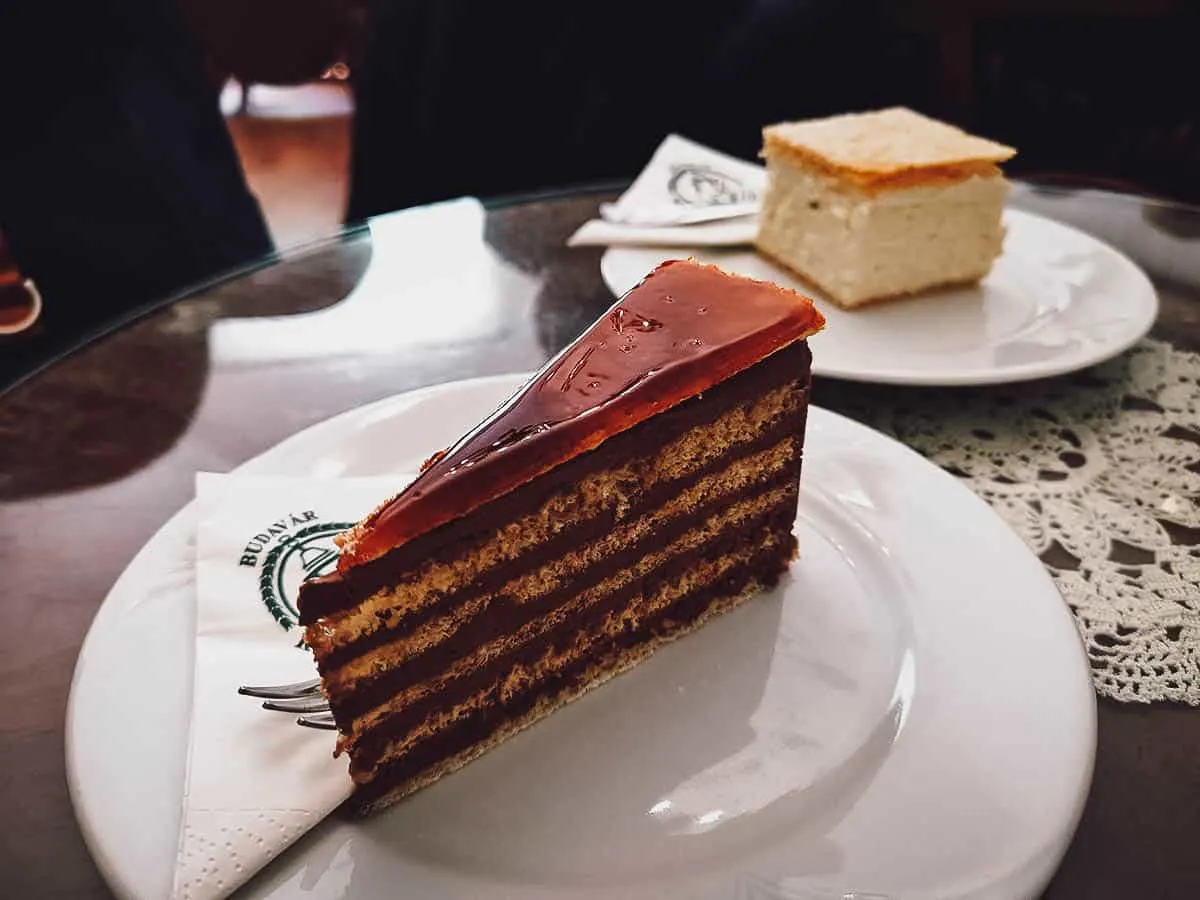
21. Mádartej
As a kid, I used to look up at the sky and think: “Hmmm, I wonder what that cloud tastes like?” These fluffy egg white clouds floating on a creamy vanilla custard remind me of those innocent times.
Called madartej in Hungary, this dreamy dessert of French origin (oeufs a la neige) consists of meringue floating in a smooth and silky pool of creme anglaise. Light and easy to prepare, it can be made with just five ingredients – eggs, milk, cornstarch, vanilla, and sugar.
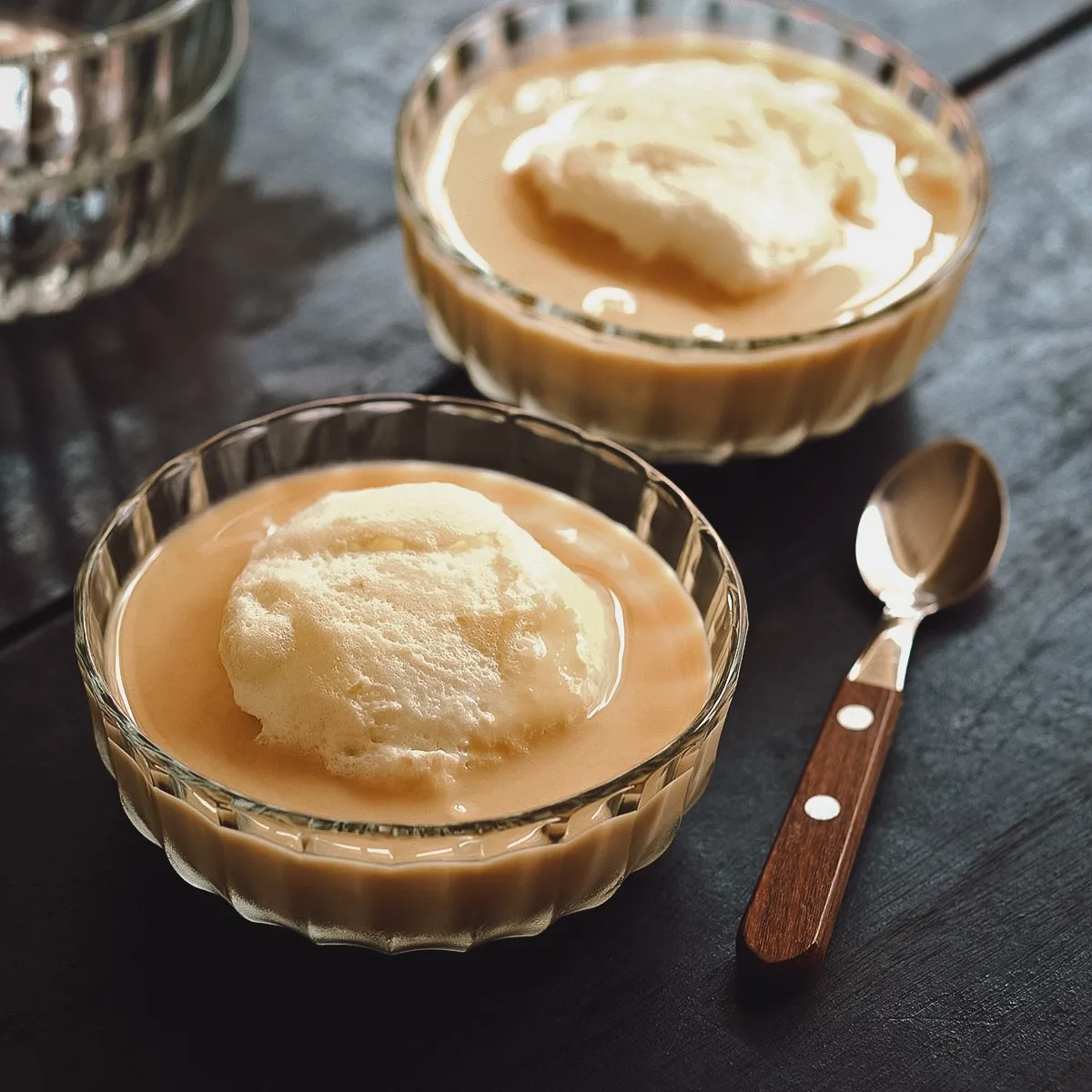
Photo by Ildi Papp
22. Mákos Guba
If you like bread pudding and visit Hungary over the Christmas season, then you should keep your eye out for makos guba. It refers to a festive Hungarian dessert made with layers of sweetened stale bread and ground poppy seeds soaked in vanilla-flavored milk.
A favorite holiday dessert, makos guba is commonly served for dessert after Christmas Eve lunch in Hungary.
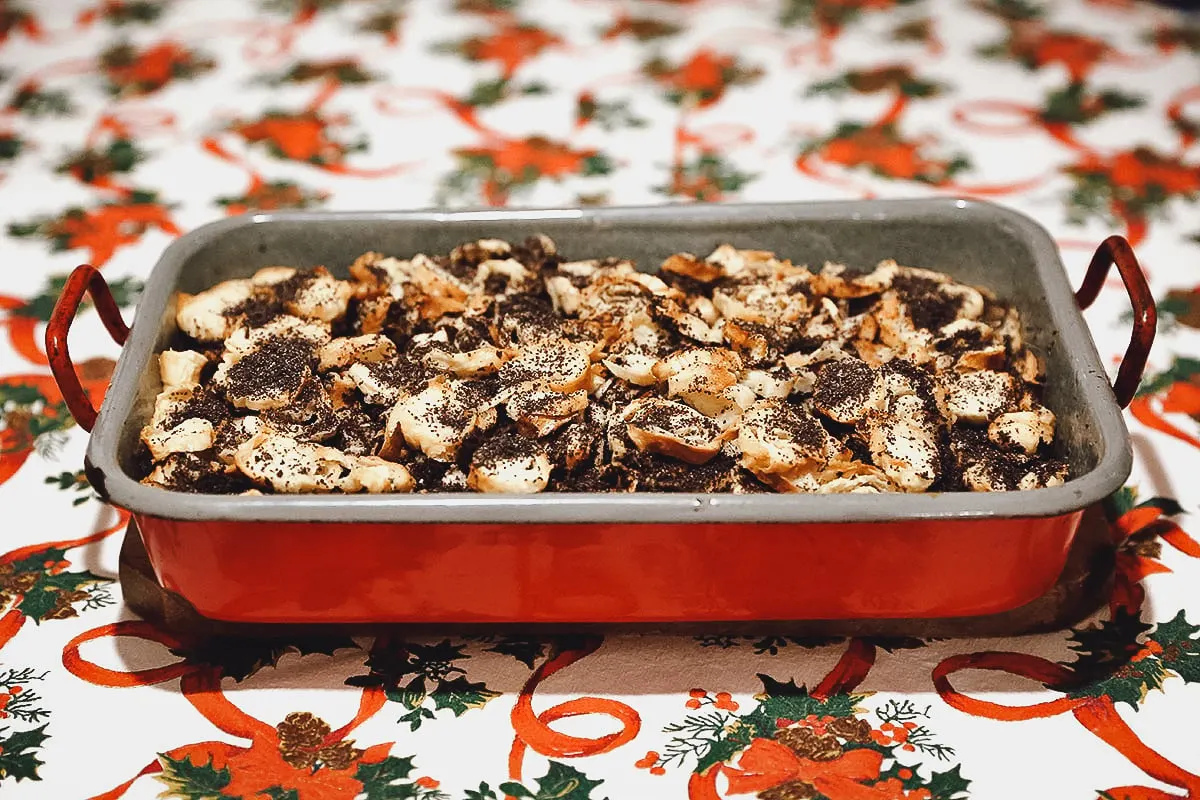
Photo by acceptphoto
23. Túrógombóc
I’m drawn to spherical desserts like profiteroles, cake balls, boba, and Chinese jiandui. The Asian-ness in me finds their auspiciously round and bite-sized shapes to be especially appealing.
In Hungary, one ball-shaped dessert you can try is turogomboc. These Hungarian cottage cheese dumplings are made from a dough of turo (cottage cheese), eggs, and semolina. The dough is shaped into bite-sized balls before being boiled and then rolled in sweetened toasted breadcrumbs.
Crunchy on the outside and tender on the inside, these tasty cottage cheese dumplings are sprinkled with powdered sugar before serving. They can also be enjoyed with a side of fruit jam or sour cream.
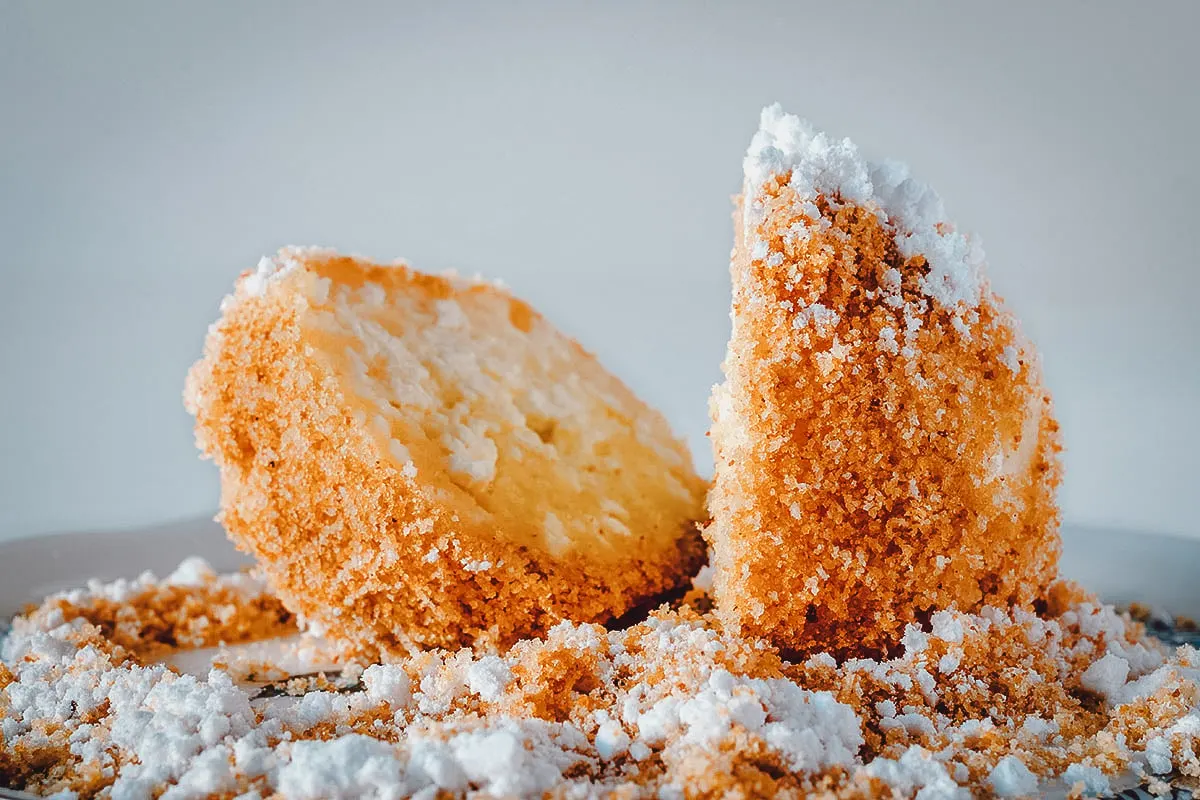
Photo by Krisztian Tefner
24. Krémes
We ate many delicious things in Budapest but this creamy pastry may have taken the cake (pun intended).
Meaning “cream cake” in Hungarian, kremes torta refers to this heavenly dessert made with a generous amount of pastry cream sandwiched between two layers of puff pastry. It’s dusted with powdered sugar before serving and best enjoyed with a cup of freshly brewed coffee. Delicious!
Kremes is a popular dessert that goes by different names throughout Europe like cremeschnitte (Germany), kremna rezina (Slovenia), napoleonka (Poland), and kremsnita (Croatia).
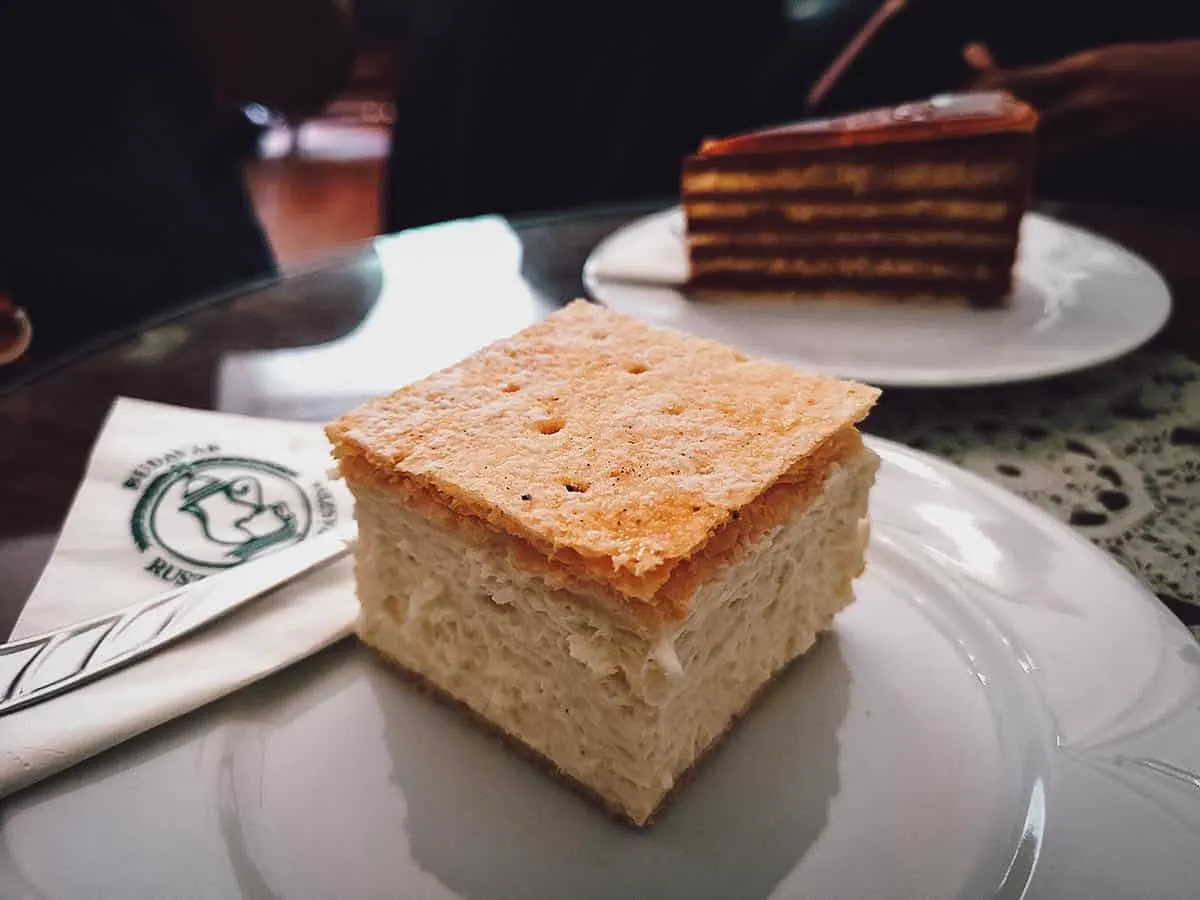
25. Szilvas Gomboc
Last on this list of must-try Hungarian food is szilvas gomboc. Like turogomboc, it’s another delicious dumpling dessert, but this time, it’s stuffed with sweet plums.
To prepare, a potato and flour dough is stuffed with plums and shaped into rounds before being boiled in water. When cooked, the dumplings float to the surface. They’re then rolled in toasted or fried breadcrumbs before being served with a dusting of powdered sugar.
These tasty Hungarian plum dumplings are especially popular in the summer when plums are in season.
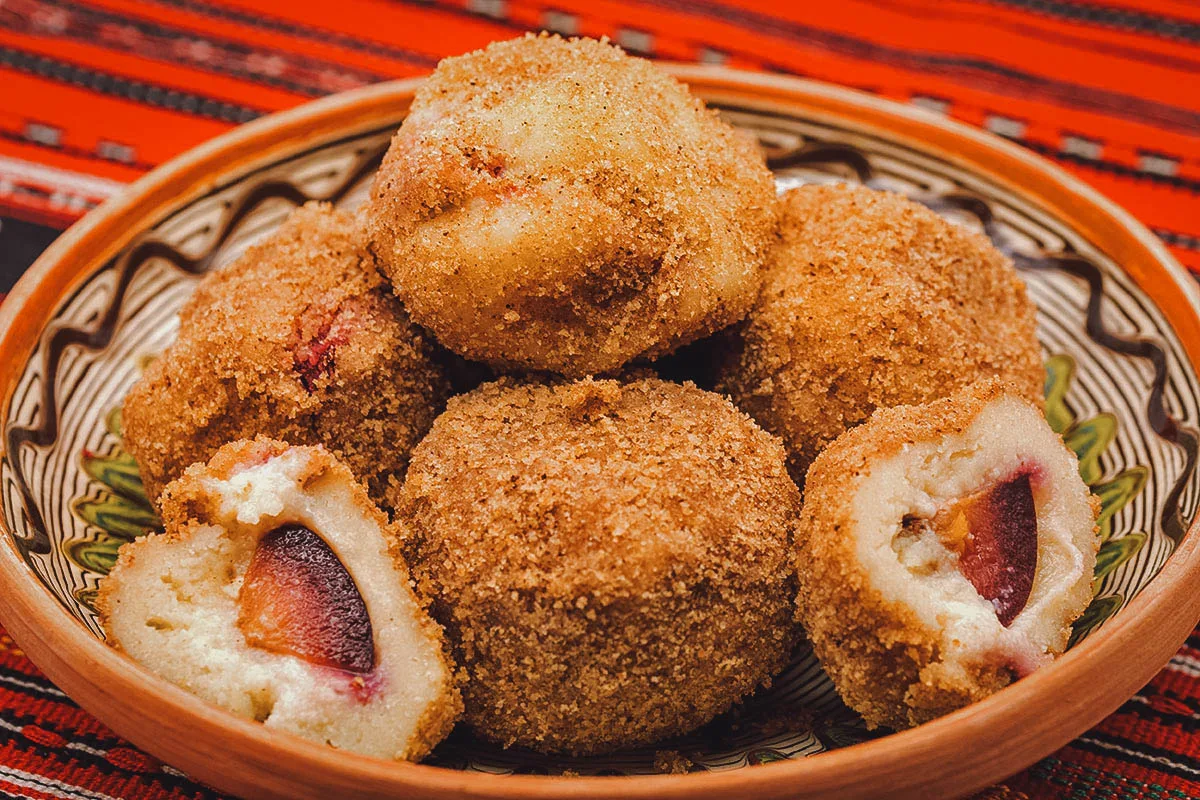
Photo by pfongabe33
FINAL THOUGHTS ON HUNGARIAN FOOD
There are many fun things to do in Budapest but trying as much Hungarian food as you can should be on your list of priorities. Typical Hungarian dishes like goulash, chicken paprikash, and langos are no-brainers but you should definitely seek out more unconventional dishes like meggyleves sweet soup and pacal porklot as well.
In any case, I hope this list of Hungarian food favorites gets you even more excited to visit Budapest or any other city in Hungary. Thanks for reading and happy traveleating!
Disclosure
This Hungarian food guide contains affiliate links, meaning we’ll earn a small commission if you make a booking at no additional cost to you. As always, we only recommend products and services that we use ourselves and firmly believe in. We really appreciate your support as this helps us make more of these free food and travel guides. Thank you!
Cover photo by Morana Photo. Stock images via Shutterstock.

